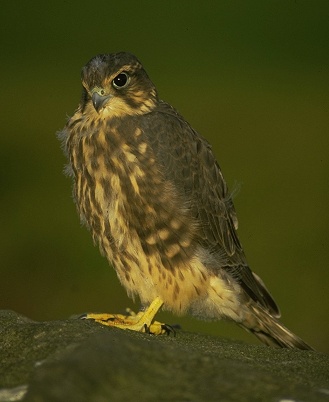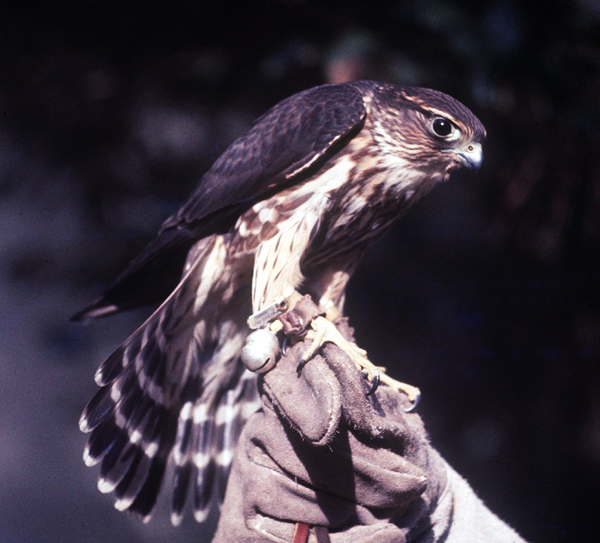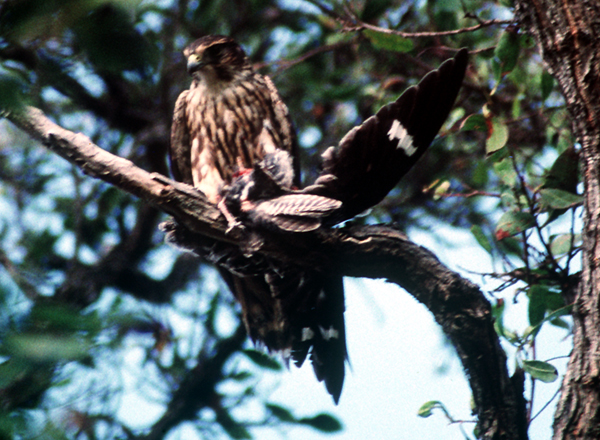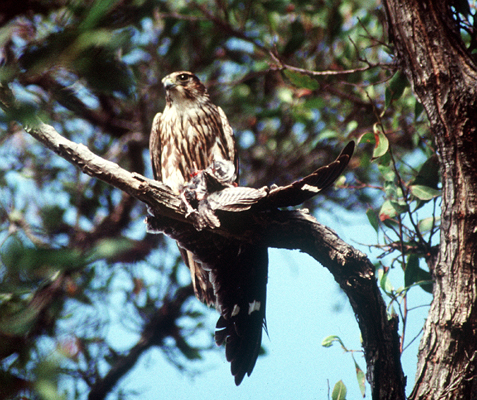|
Merlin Falco columbarius Esmerejón,
|
 |
|
Photo: J. Hornbuckle
|
|
Merlin Falco columbarius Esmerejón,
|
 |
|
Photo: J. Hornbuckle
|
|
IDENTIFICATION: A small falcon, with heavy streaking below, and wide, contrasting dark and light bars on the tail. The male has a blue-gray back, while the larger female has a brown back. In immature plumage both sexes are chocolate brown, with heavily streaked breasts, and strongly barred tails. In flight, the wings appear long and pointed, and it can be confused at first glance with a pigeon. As a result it used to be called the Pigeon Hawk (also a translation of its Latin name). Distinguished from the more common American Kestrel in flight by a stronger wing beat, a generally more robust appearance, and overall darker coloration. Length: 24-33 cm.; average weight: males 165 g., females 230 g.; wingspan 50-67 cm. VOICE: The call is a series of sharp notes: "kek kek kek", but usually quiet away from the breeding grounds. Audio 2 (M. Oberle, R. De Witt)* HABITAT: In winter, the Merlin occurs at edges of agricultural areas, coasts, saltflats, clearings in wet, dry and elfin forest, and in towns. HABITS: The Merlin primarily hunts birds. Over 90% of its diet consists of small birds up to the size of sandpipers. It searches for prey from an exposed perch or by flying low over open areas. It puts on a dramatic burst of speed as it homes in on a bird, often capturing the bird in mid-air. It kills with a bite to the back of the neck, and often pulls off the head, feathers and wings before eating the body of its prey. Less than one out of every four attempts to catch a bird is successful. The Merlin will also eat some small rodents and large insects, such as dragonflies. Unlike the commoner American Kestrel, the Merlin does not bob its tail up and down when perched. It breeds in northern North America and Eurasia, but instead of building its own nest, it takes over the abandoned nest of a crow, hawk or other bird. Although both sexes incubate, the male provides most of the food for the female while she incubates the 4-5 eggs for about 30 days. The male continues to provide most of the food for fledglings until the chicks leave the nest about 29 days after hatching. Merlins start to breed at 2-3 years of age. STATUS AND CONSERVATION: An uncommon but regular winter resident in Puerto Rico. Most Merlins that breed in northeastern North America winter in the Caribbean. Merlins banded in New York State and Wisconsin have been recovered in Puerto Rico. The Merlin suffered from eggshell thinning and reduced breeding success during the mid-20th Century due to exposure to DDT and other persistent pesticides. This threat has subsided, but the Merlin still suffers from illegal shooting, collisions with cars and towers, and destruction of breeding and wintering habitat. It is still used in the sport of falconry, and was especially popular among falconer "ladies" in Medieval times. RANGE: In the New World, the Merlin nests in the northwestern USA, northern Michigan, Wisconsin and Maine, and in almost all of Canada and Alaska south of the tundra. It winters from coastal Alaska and southwestern Canada, through the western states and East Coast of the USA, south to Peru, Ecuador, Colombia, and Venezuela. A regular location to find this species is along the mudflats at Cabo Rojo National Wildlife Refuge, where it patrols the shores looking for sandpipers. TAXONOMY: FALCONIFORMES; FALCONIDAE; Falconinae. Formerly called the Pigeon Hawk. |
 |
|
Photo: J. Volpi*
|
 |
|
Photo: J. Volpi*
|
 |
|
With a Common Nighthawk - Photo: G. Beaton
|
 |
|
With a Common Nighthawk - Photo: G. Beaton
|
|
References del Hoyo, J., A. Elliott, and J. Sargatal, eds. 1994. Handbook of Birds of the World, Vol. 2, New World vultures to guineafowl. Lynx Edicions, Barcelona. Griffiths, C. S. 1999. Phylogeny of the Falconidae inferred from molecular and morphological data. Auk 116(1):116-130. Johnsgard, P.A. 1990. Hawks, eagles, and falcons of North America: Biology and natural history. Smithsonian Institution Press. Washington, DC. Raffaele, H.A. 1989. A guide to the birds of Puerto Rico and the Virgin Islands. Princeton. Raffaele, H.A. 1989. Una guía a las aves de Puerto Rico y las Islas Vírgenes. Publishing Resources, Inc., Santurce, PR. Raffaele, H.A., J.W. Wiley, O.H. Garrido, A.R. Keith, and J.I. Raffaele. 1998. Guide to the birds of the West Indies. Princeton. Rivera-Milán, F.F. 1995. Distribution and abundance of raptors in Puerto Rico. Wilson Bull. 107(3):452-462. Saliva, J.E. 1994. Vieques y su fauna: Vieques wildlife manual. U.S. Fish & Wildlife Service, Boquerón, PR. Scholz, F. 1993. Birds of prey. Stackpole Books, Mechanicsburg, PA. Sodhi, N.S., L.W. Oliphant, and I. G. Warkentin. 1993. Merlin (Falco columbarius). No. 44 in The birds of North America (A. Poole and F. Gill, eds.). The Birds of North America, Inc., Philadelphia, PA. Raptors in general in Puerto Rico: http://netdial.caribe.net/~falconpr/ Next related species in taxonomic order Previous related species in taxonomic order |